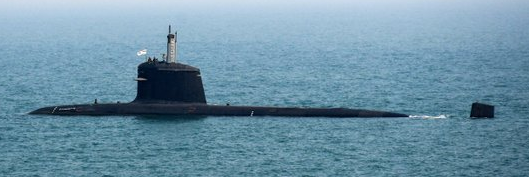New Delhi: Amid rising diplomatic tensions with Canada and ongoing threats from neighbouring adversaries, India quietly launched its fourth nuclear-powered ballistic missile submarine (SSBN) this week at the Ship Building Center (SBC) in Visakhapatnam, further enhancing its nuclear deterrence capabilities, a source said Tuesday.
India’s second SSBN, INS Arighaat, was commissioned by Defence Minister Rajnath Singh August 29, 2024, while the third SSBN INS Aridhaman is scheduled for commissioning next year.
The Union Cabinet Committee on Security (CCS) October 9 approved the construction of two additional nuclear-powered attack submarines to fortify India’s defence posture in the Indo-Pacific.
Despite a low-profile stance from the government regarding nuclear deterrence, the fourth SSBN, code-named S4, was launched October 16. This discreet event followed the inauguration of a Very Low Frequency (VLF) Naval Station by Rajnath Singh in Telangana’s Vikarabad district, designed to enhance communication with the Indian Navy’s strategic assets.
Why codename ‘S4’?
The Indian Navy’s first leased nuclear submarine, INS Chakra, was designated as S1, followed by INS Arihant as S2, INS Arighaat as S3, and now INS Aridhaman as S4. The newly launched S4 marks the final vessel of this class, although its formal name is yet to be confirmed.
Difference between launching and commissioning
Though, the S4 is reportedly launched but is yet to be commissioned.
The main difference between launching and commissioning a ship is that launching is the process of moving a ship from land to water, while commissioning is the ceremony of placing the ship into active naval service:
Focus on sea-based deterrence
Under Prime Minister Narendra Modi’s leadership, India’s strategic focus has shifted toward bolstering sea-based deterrence, primarily through the deployment of nuclear-armed submarines, especially in light of China’s growing military presence. Aircraft carriers, while formidable, are seen as vulnerable to long-range missiles such as China’s Dong Feng-21 and Dong Feng-26, which has led to prioritizing the SSBNs over a third aircraft carrier for the Indian Navy.
In addition to strengthening its nuclear submarine fleet, India is boosting its conventional submarine force. The sixth diesel-powered attack submarine of the Kalvari class, INS Vagsheer, is set for commissioning in December 2024. Furthermore, the government is likely to approv the construction of three advanced diesel submarines in collaboration with the French Naval Group at Mazagon Dockyards.
READ ALSO | PM Modi reaches Russia, to meet leaders on sidelines of BRICS Summit in Kazan
With an increasing number of PLA warships frequently patrolling the Indian Ocean in last few years last year and China’s anticipated carrier-based patrols by 2025–26, India’s strategic submarines will play a pivotal role in safeguarding its maritime interests and asserting dominance in the region.
Strategic need for a third SSBN
Despite the addition of INS Arighaat, India’s submarine fleet still lacks the capacity to maintain the “Continuous At Sea Deterrence” (CASD) status, wherein at least one nuclear-armed submarine remains on active patrol at all times.
According to a report by Lowy Institute, a minimum of three SSBNs is essential to achieve this capability. Both the UK and France among other countries maintain continuous deterrence with a fleet of four SSBNs each.
Enhancing second-strike capabilities
The commissioning of INS Arighaat is poised to significantly influence strategic dynamics in the Indo-Pacific by reinforcing India’s second-strike capability. This ability allows a nation to launch a retaliatory nuclear attack after surviving an initial strike, thus acting as a vital deterrent.
Countries like the United States ensure second-strike capability through diversified nuclear launch platforms, including submarines, which remain functional even if other systems are neutralised. The Cold War-era belief in the importance of second-strike capability still holds relevance today.
With two SSBNs in rotation, India can maintain a consistent deterrence presence while conducting necessary maintenance and training. As India’s nuclear deterrence grows, so does its role as a net security provider in the Indian Ocean region, fostering partnerships with countries like the United States, Australia and Japan. By bolstering its second-strike capacity, India enhances its ability to deter aggressive actions from powers such as China and preserve stability in the region.
PNN
